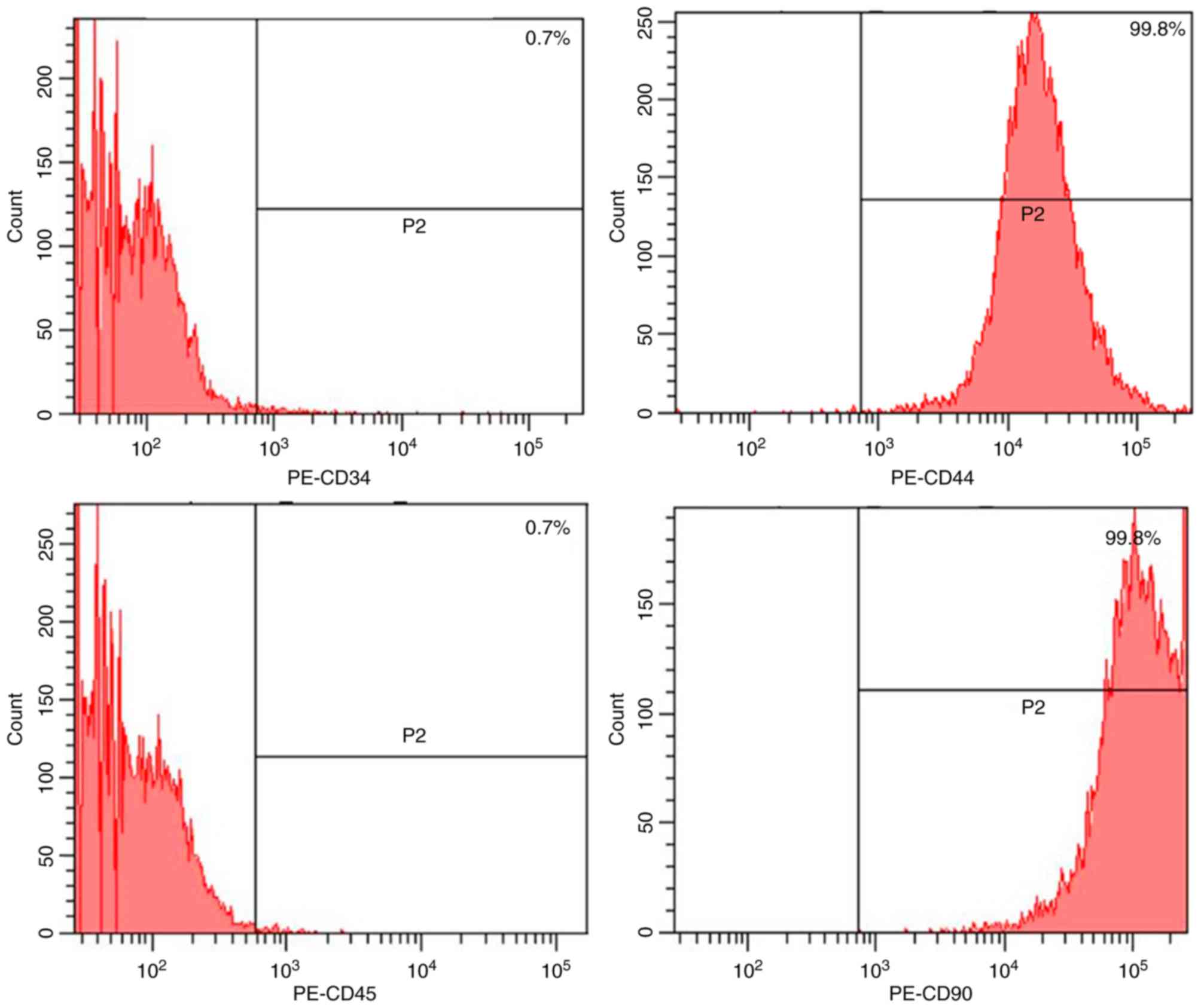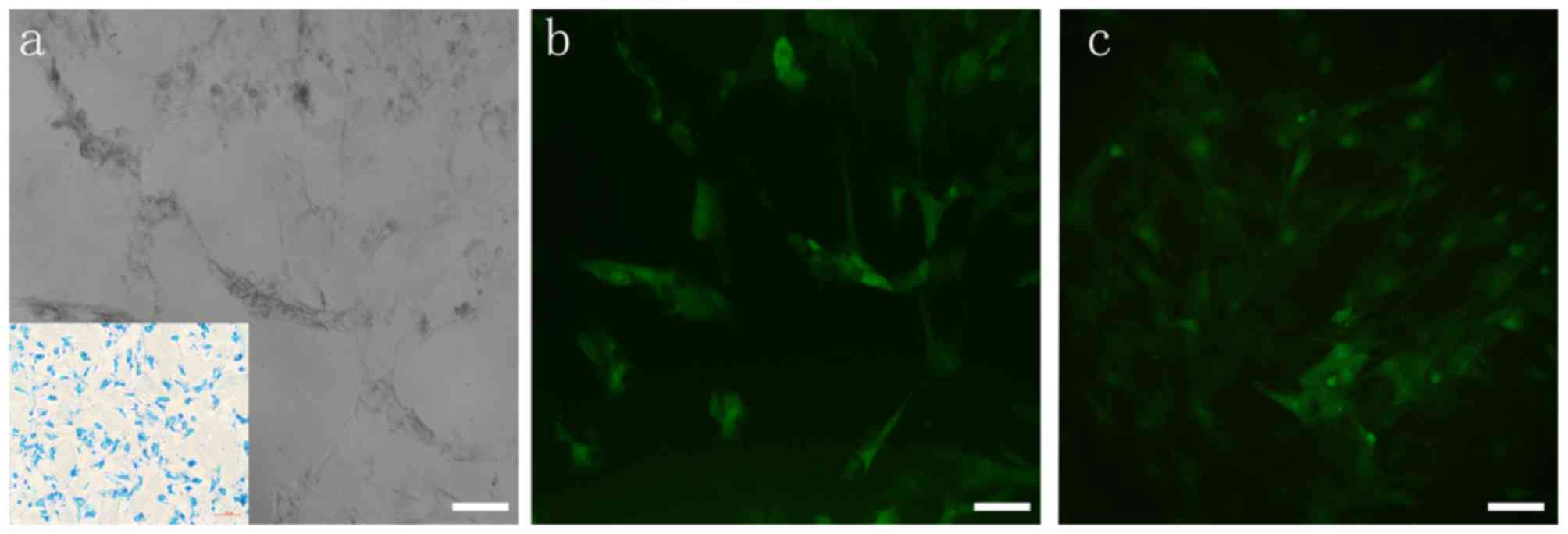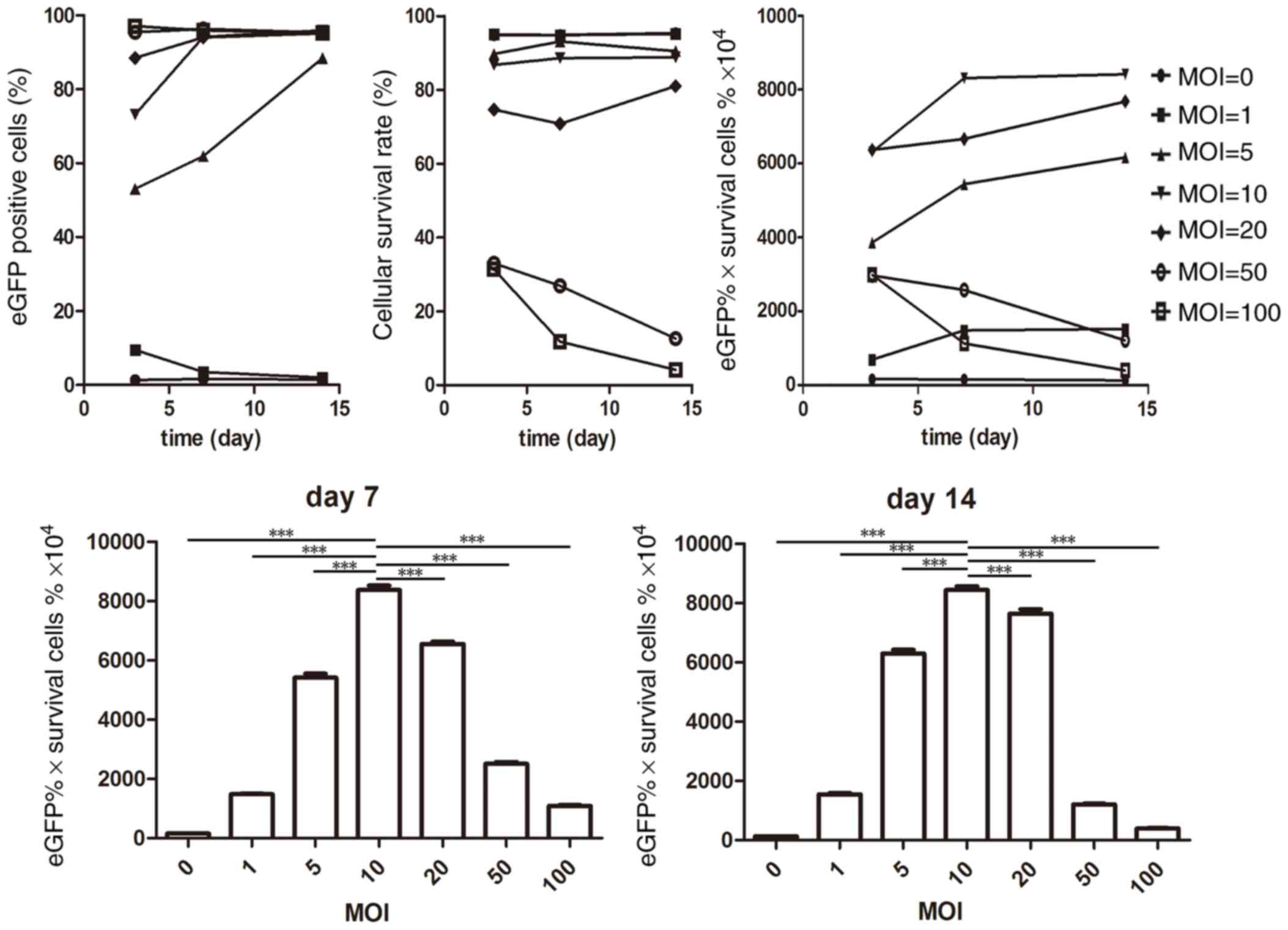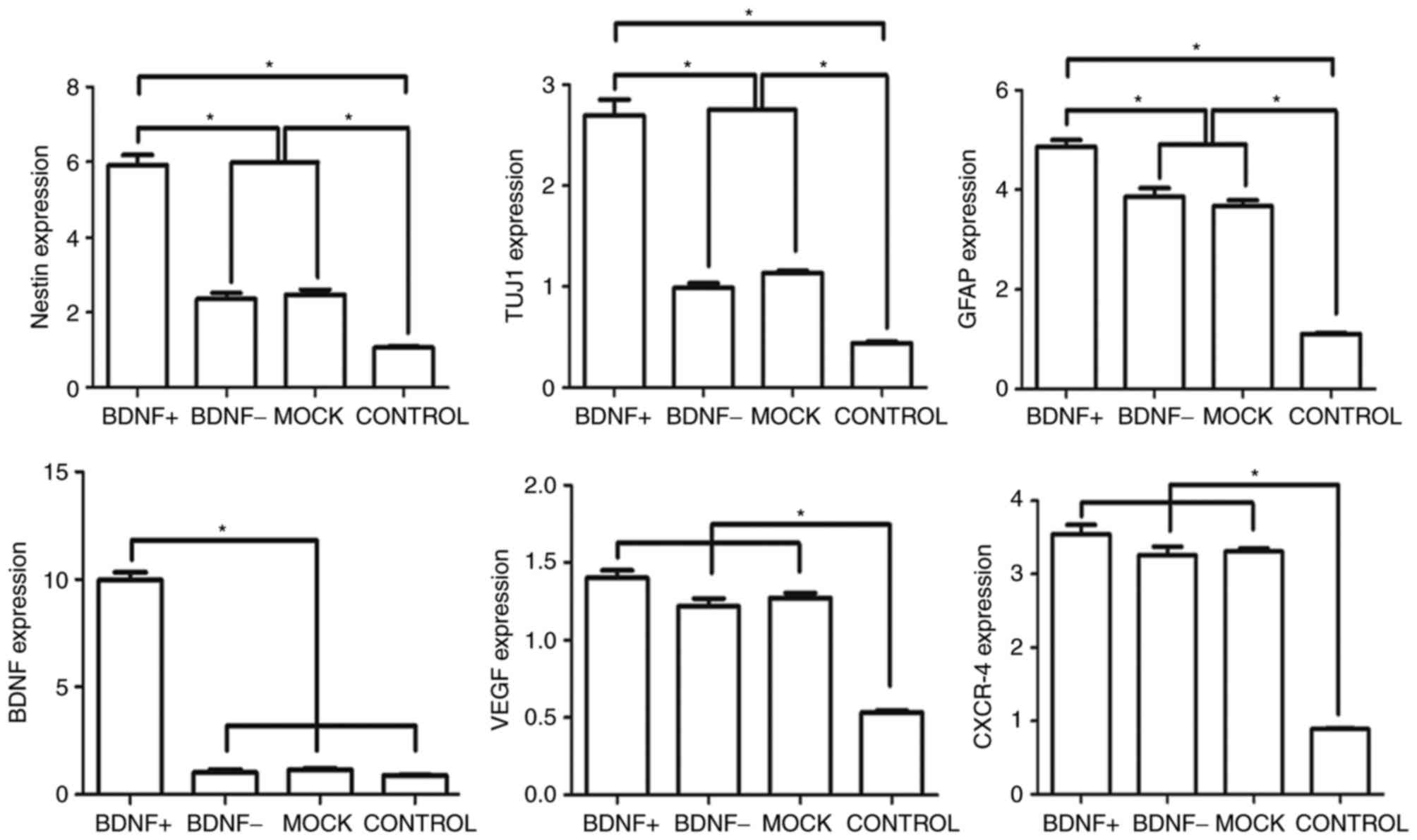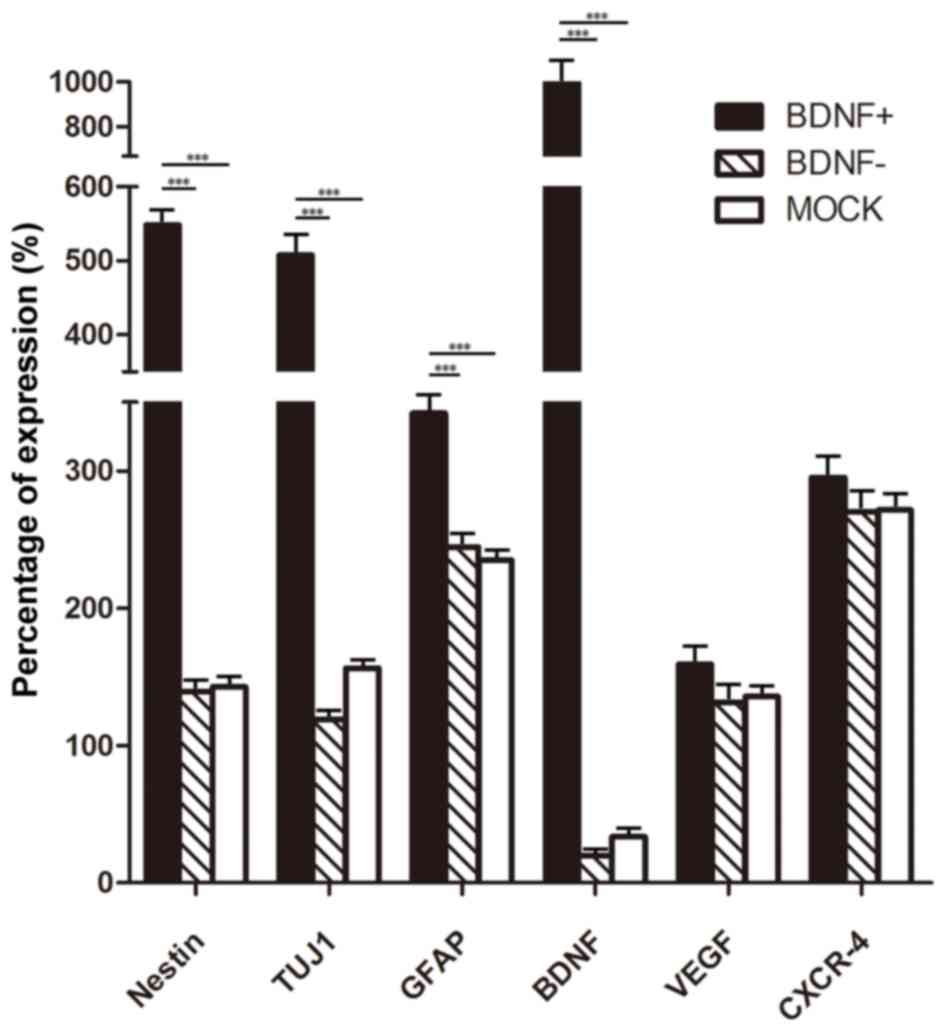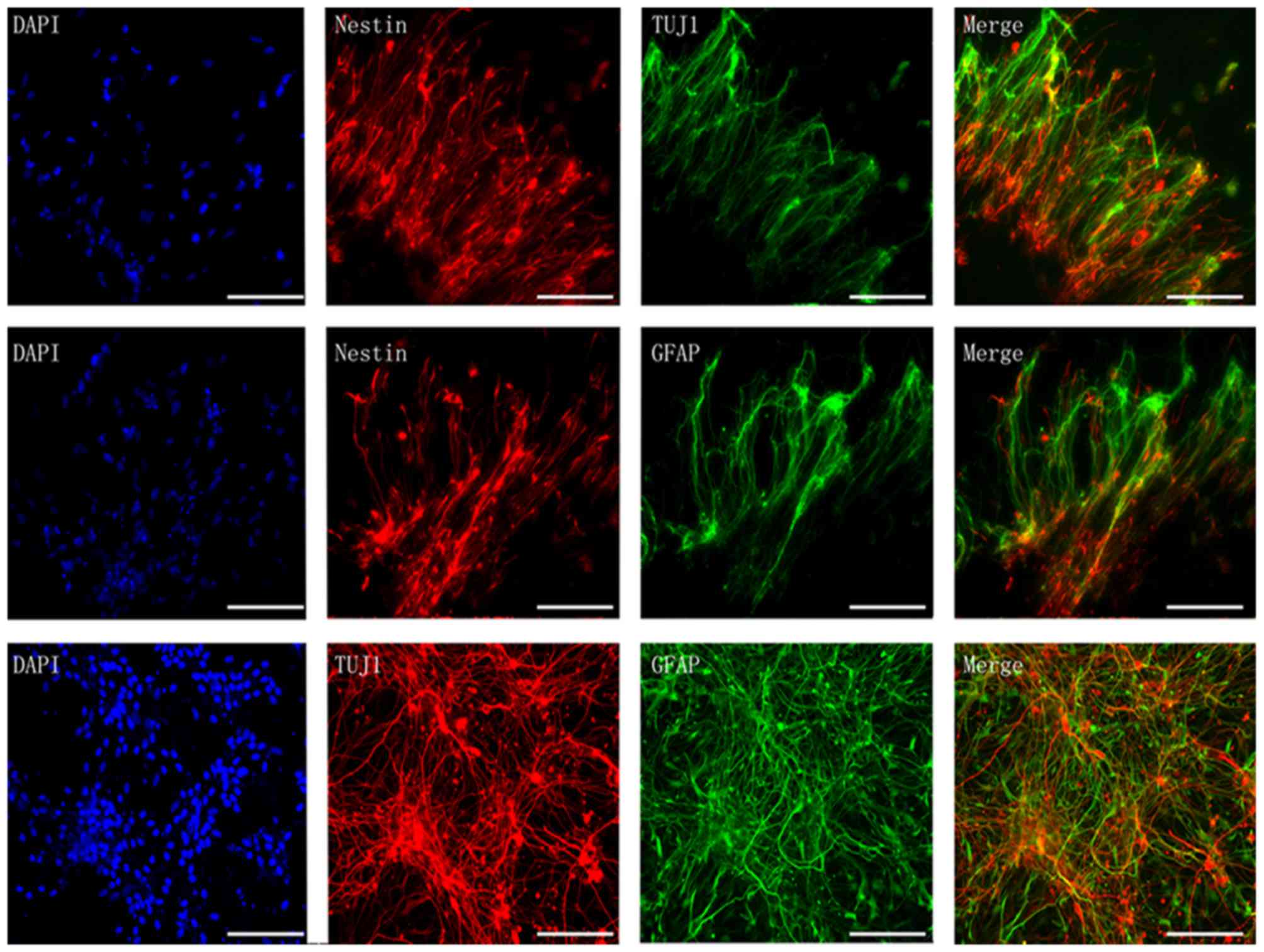Differentiation of genetically modified canine bone mesenchymal stem cells labeled with superparamagnetic iron oxide into neural‑like cells
- Authors:
- Published online on: April 5, 2018 https://doi.org/10.3892/mmr.2018.8847
- Pages: 7902-7910
Abstract
Introduction
Mesenchymal stem cells (MSCs) have been used as a powerful stem cell source for cellular transplantation therapy, as they exhibit numerous advantages (1–4). MSCs may be easily obtained from various types of tissues, and differentiate into different cell and tissue types with immunomodulatory properties (5) and homing capacity (6). MSCs produce cytokines and chemokines that may promote cell proliferative, anti-apoptotic, anti-inflammatory and cell homing effects in wounded areas (7,8). Brain-derived neurotrophic factor (BDNF) is a cytokine secreted by MSCs and has neuroprotective, neurogenic and angiogenic effects, thus promoting recovery after central nervous system (CNS) insult (9,10). Modified MSCs overexpressing BDNF may theoretically improve their therapeutic effect.
Although certain studies using genetically modified techniques have exhibited promising results in cell culture and small-animal CNS insult models, further preclinical research is required in large animals due to numerous discordances between laboratory and clinical research (11). Additionally, the labeling of superparamagnetic iron oxide (SPIO) nanoparticles of cells is a way of tracing the distribution and migration of transplanted cells in large animals by magnetic resonance imaging (MRI) in vivo with minor effects on cell viability (12,13). However, few studies have reported the efficiency of genetically modified MSCs after labeling with SPIO, especially for large animals such as canines, which may be used as a suitable model of human neurological disease and is evaluated by MRI (12,14).
Therefore, in this study, SPIO-labeled canine BMSCs were used to evaluate the feasibility of BDNF gene lentiviral transfection and the neural differentiation efficiency after gene modification.
Materials and methods
Cell culture and identification
Bone marrow was extracted from the humerus of 20 healthy adult beagle dogs of either sex (sex ratio, males to females 3:1) and 14.62±1.1 kg body weight (Laboratory Animal Centre, Anhui, China) as previously described (12). All dogs were housed in a single cages separately at well-ventilated facility with purified air and 12 h light/dark cycle at 24–28°C and fed twice a day with commercial dry food and sterile water ad libitum. The National Institutes of Health (Bethesda, MD, USA) and Institutional Animal Care and Use Committee (IACUC) guidelines for use of animals in research were followed, under an approved IACUC protocol of Nanjing Medical University (Nanjing, China). MSCs were isolated and purified from the bone marrow by density gradient centrifugation and plastic wall adherence. Briefly, the bone marrow was layered onto a density gradient solution at 1:1 volume ratio with equal volume (Ficoll-Paque; Tianjin Haoyang Biological Products Technology Co., Ltd., Tianjin, China), and centrifuged for 20 min at 400 × g at 4°C. Enriched cells were obtained from the solution interphase and washed twice with PBS, then cultivated in normal culture medium: Low-glucose Dulbecco's modified Eagle medium (DMEM; Gibco; Thermo Fisher Scientific, Inc., Waltham, MA, USA) supplemented with 10% fetal bovine serum (FBS; Gibco; Thermo Fisher Scientific, Inc.), 100 IU/ml penicillin and 100 µg/ml streptomycin at 37°C and 5% CO2. Primary isolated MSCs were defined as passage (P)0. When 80–90% confluence was reached, the cells were passaged (1:2 or 1:3 dilutions) with fresh medium.
To determine the expression of MSC markers [cluster of differentiation (CD)34-, CD45-, CD44+ and CD90+], P2 BSMCs were used for flow cytometry (BD FACSCalibur; BD Biosciences, Franklin Lakes, NJ, USA). In brief, BMSCs were collected in FACS tubes (BD Biosciences) at 1×106 cells/tube and washed with PBS. Cells were incubated with antibodies at room temperature for 1 h. The antibodies included: anti-CD34 (cat. no. ab81289), CD45 (cat. no. ab123522), CD44 (cat. no. ab157107), CD90 (cat. no. ab123511; all Abcam, Cambridge, UK) all at 1:200. Labeled cells were washed twice with PBS and re-suspender in 500 µl FACS buffer. Subsequently, the cells were incubated with rabbit anti-mouse immunoglobulin G secondary antibody labeled with phycoerythrin (1:1,000; cat. no. ab7000; Abcam) of for 1 h. The expression of these markers was evaluated using FlowJo software (version 7.6.3; FlowJo LLC, Ashland, OR, USA) for data analysis.
To determine the multiple differentiation capacity, P3 BMSCs were induced to osteoblastic and adipose differentiation as previously reported (1). For osteogenic differentiation, cells were seeded at a density of 4.5×104 cells/cm2 and cultured with induction medium containing DMEM supplemented with 10% FBS (both Gibco; Thermo Fisher Scientific, Inc.), 100 nM dexamethasone, 10 mM β-glycerol-phosphate, and 100 µg/ml ascorbic acid (all purchased from Sigma-Aldrich; Merck KGaA, Darmstadt, Germany) at 37°C and 5% CO2. The induction medium was changed every 3 days. After 14 days of induction, cells were fixed in 70% ethanol and stained with 2% Alizarin Red at room temperature for 10 min. For adipogenic differentiation, cells were plated at a density of 1.0×104 cells/cm2. Similarly, adipogenesis was induced by culturing with induction medium containing DMEM supplemented with 5% rabbit serum (Gibco; Thermo Fisher Scientific, Inc.), 5 µg/ml insulin, 1 µM dexamethasone and 5 µg/ml rosiglitazone (all obtained from Sigma-Aldrich; Merck KGaA) at 37°C and 5% CO2. The induction medium was changed every 3 days. After 21 days of induction, cells were fixed in 70% ethanol and stained with 0.3% Oil Red O at room temperature for 60 min.
SPIO labeling
BMSCs were cultured in 10 cm dish at 2×106 with fresh medium containing SPIO-poly-L-lysine (Nanjing Nanoeast Biotech, Co., Ltd., Nanjing, China) at 20 µg/ml for 24 h and then were washed three times in PBS to eliminate extracellular SPIO. Efficiency of SPIO labeling was confirmed by Prussian blue (PB) staining (12). In brief, the cells were incubated with PB (2% potassium ferrocyanide in 6% hydrogen chloride) for 15 min at room temperature and then counterstained with nuclear fast red for 1 min at room temperature. The percentage of iron-containing cells was calculated according to the positively-stained cell numbers with light microscope (IX71; Olympus Corp., Tokyo, Japan).
Lentivirus transfection
SPIO-BMSCs were seeded in 96-well plates at 1×104 cells per well (100 µl), cultured overnight and transfected with enhanced green fluorescent protein (eGFP)(+)-BDNF(−)-lentivirus (Shanghai GeneChem, Co., Ltd., Shanghai, China) at a multiplicity of infection (MOI) of 0, 1, 5, 10, 20, 50 and 100. After 12 h, transfection medium was changed to normal culture medium without lentiviral particles, and cells were cultured as routine. MSCs were used for analysis at day 3, 7 and 14. The percentage eGFP-positive cells was detected by Guava Express analysis on a GuavaEasyCyte™ flow cytometer (Guava Technologies; EMD Millipore, Billerica, MA, USA). At each time point, the cellular viability was evaluated by using a Cell Counting kit-8 (CCK-8; Dojindo Molecular Technologies, Inc., Kumamoto, Japan). In brief, 10 µl CCK-8 was added into each well and after 4 h incubation, and the optical density value was measured at a wavelength of 450 nm using a microplate reader (Thermo Fisher Scientific, Inc.). The optimal MOI was calculated by multiplication of the percentage eGFP positive cells by the average cellular survival rate.
BMSC neural differentiation
After determination of the optimal MOI, SPIO labeled MSCs were divided into 4 groups: Transfection at optimized MOI with eGFP(−)-BDNF(+)-lentivirus (BDNF+ group), transfection at optimized MOI with eGFP(−)-BDNF(−)-lentivirus (BDNF-group) and non-transfected group (mock group), for neural differentiation and subsequent analysis. The non-transfected group without neural differentiation was used as control group (control group). Neural differentiation was induced as previously reported (15,16) in BDNF+, BDNF- and mock group cells. Briefly, BMSCs were cultured with DMEM + 10% FBS until sub-confluence. BMSCs were pre-induced for 24 h with DMEM + 20% FBS + 1 mM β-mercaptoethanol, then were induced for 8 h with DMEM + 100 mM butylated hydroxyanisole (BHA) + 2% dimethylsulfoxide (DMSO). Finally, of the media of the cells was replaced with maintenance media containing DMEM + 100 mM BHA + 2% DMSO + 25 mM KCl + 2 mM valproic acid + 10 µM forskolin + N2 supplement for 1–3 days. BMSCs in the control group were cultured with DMEM + 10% FBS.
Reverse transcription-quantitative polymerase chain reaction (RT-qPCR)
Expression of cytokines [(BDNF, vascular endothelial growth factor (VEGF) and chemokine receptor type 4 (CXCR-4)] and neural precursor cells (indicated by nestin expression), neurons [indicated by class 3 β tubulin (TUJ1) expression], neurogliocytes [indicated by glial fibrillary acidic protein (GFAP) expression] and oligodendrocytes (oligo1) were analyzed by RT-qPCR. Total RNA was extracted from cultured cells using TRIzol reagent (Thermo Fisher Scientific, Inc.) according to the manufacturer's protocol. RNA was used for cDNA synthesis using a Prime Script RT Reagent kit according to the manufacture's protocol and oligo dT primers (Takara Biotechnology, Co., Ltd., Dalian, China). Briefly, the first-strand cDNA was obtained by reverse transcription using 3 µl of total RNA at 37°C for 15 min and 85°C for 5 sec. RT-qPCR was performed at 95°C for 5 sec and 60°C for 34 sec in 20 µl buffer containing SYBR premix ExTaq II and ROX Reference dye (Takara Biotechnology, Co., Ltd.) and 0.2 µM each of the primers and SYBR Premix DimerEraser (Takara Biotechnology, Co., Ltd.) on a 7900HT system (ABI Prism® 7900HT; Thermo Fisher Scientific, Inc). Glucuronidase β was used as an internal control. The relative level of gene expression for each sample was calculated using the 2−ΔΔCq method (17). Primer sequences are listed in Table I.
Immunofluorescence
To confirm the differentiation of the BMSCs, neuron-like cells were analyzed by immunofluorescence using antibodies against nestin, GFAP and TUJ1. The primary antibodies included mouse anti-nestin (1:200; cat. no. ab22035), mouse anti-GFAP (1:200; cat. no. ab53554), rabbit anti-nestin (1:200; cat. no. ab105389) and rabbit anti-class 3 β tubulin (1:500; cat. no. ab7751; all Abcam). Cells were fixed with 4% paraformaldehyde at room temperature for 20 min. Cells were washed three times with PBS and blocked with 0.4% Triton X-100 (Sigma-Aldrich; Merck KGaA) at 4°C for 10 min. Then cells were washed three times with PBS and immersed with 5% bovine serum albumin at 37°C for 30 min. Following incubation with the primary antibodies overnight at 4°C, the cells were washed three times with PBS, followed by incubation with fluorescent goat anti-mouse immunoglobulin G (IgG) antibody (cat no. ab150113), goat anti-mouse IgG antibody (cat no. ab97035), goat anti-rabbit IgG (cat no. ab150079) and goat anti-rabbit IgG (cat no. ab6787; all Abcam) at room temperature for 60 min, all at 1:200. Following washing, the cells were stained with 100 ng/ml DAPI for 10 min at room temperature and mounted with anti-fade mounting medium (both Sigma-Aldrich; Merck KGaA), and observed under a fluorescent microscope. BMSCs that expressed neural (neuron or glia) markers were considered to be immunopositive cells.
Statistical analysis
All analyses were performed in a double-blinded manner. All values are expressed as the mean ± standard deviation. Student's t-test and one-way analysis of variance followed by Bonferroni's post hoc analysis were used for single and multiple comparisons, respectively. Data was calculated using SPSS software version 17.0 (SPSS, Inc., Chicago, IL, USA). P<0.05 was considered to indicate a statistically significant difference.
Results
Morphology and phenotypes of cultured BMSCs
Following isolation by density gradient centrifugation from canine bone marrow, BMSCs were cultured in growth medium. After 14 days of culturing, the cell morphology was altered from various shapes including discoidal flat, triangular and elongated, to a spindle shape under a light microscope (Fig. 1a). After 14 days of osteogenic differentiation, the cells differentiated into the osteogenic lineage, as demonstrated by slizarin red staining (Fig. 1b). Additionally, after 21 days of adipogenic differentiation, these cells differentiate into adipocytes with lipid droplets stained with Oil red O (Fig. 1c). Flow cytometry analysis (Fig. 2) revealed that passage 2 BMSCs (7-day culture) were positive for CD44 and CD90 and negative for CD34 and CD45.
SPIO labeling
The uptake mechanism of SPIO particles by BMSCs is mediated by endocytosis. In a previous study, 20 µg/ml was chosen as the optimal concentration for high uptake efficiency and minimal cytotoxicity (12). After incubation with SPIO for 24 h, SPIO particles (blue staining; Fig. 3a) were visible following PB staining, and the labeling percentage of SPIO was ~100% (Fig. 3a).
Optimized MOI of lentivirus transfection
After incubation with eGFP(+)-BDNF(−)-lentivirus for 12 h, SPIO-labeled BMSCs (Fig. 3a) exhibited positive eGFP expression on day 3 (Fig. 3b), and proliferated with positive eGFP expression on day 7 (Fig. 3c). As demonstrated in Fig. 4, the eGFP expression rate was MOI dose-dependent at day 3 and exhibited a ≥80% positive rate when MOI ≥5 was used at day 14. However, with the increasing of MOI, the cellular survival rate decreased (MOI 50 and 100). Following combining the eGFP positive rate and the average cellular survival rate at different MOIs, it was revealed that at MOI 10, BMSCs exhibited higher eGFP expression and proliferation capacity at day 7 and this was maintained at day 14, (% eGFP x% survival cells ×104 were 8752.37±242.11 and 8464.76±273.40 at day 7 and 14, respectively; P<0.0001).
Expression of BDNF and neural markers
To determine the expression of cytokines and neural markers following SPIO-BMSCs neural differentiation, the expression levels of cytokines (BDNF, VEGF and CXCR-4), and neural precursor cells (nestin), neurons (TUJ1) and neurogliocytes (GFAP) were detected. As exhibited in Fig. 5, following neural differentiation, the neural markers (nestin, TUJ1 and GFAP) were significantly increased in the differentiation groups compared with the control group. Additionally, VEGF and CXCR-4 were also increased markedly in the differentiation groups compared with the control, which are important for vascular formation and cell homing, respectively. The expression of BDNF was not increased following neural differentiation in the BDNF- and the mock groups; however, in the BDNF+ group, the expression of BDNF was significantly increased compared with the mock group, which suggested that there was positive gene expression during neural differentiation. Although not significant, the expression of VEGF and CXCR-4 in the BDNF+ group was also higher than the other differentiated groups. The relative percentages of expression of neural markers and cytokines in the BDNF+, BDNF- and mock groups were evaluated (Fig. 6). The percentage of expression was calculated as follows: Expression in differentiation groups - the expression in the control group)/the expression in control group ×100. When comparing the BDNF+ group with the other two groups, the percentage BDNF expression was ~10 fold higher. Expression of neural markers of nestin, TUJ1 and GFAP also increased markedly in the BDNF+ group compared with BDNF- and mock groups (approximately 3–6 fold). Furthermore, expression of VEGF and CXCR-4 also increased in the BDNF+ group but the difference was not significant compared with BDNF- and mock groups.
Immunofluorescence of neural-like cells
As is presented in Fig. 7, following neural differentiation, the morphology of BMSCs changed to neuron-like cells with comprehensive axon-like connection with surrounding cells (Fig. 7). Additionally, the BDNF+ group presented with much more neuron-like cells than the other groups. Immunofluorescence revealed positive co-staining of nestin + TUJ1, nestin + GFAP and TUJ1 + GFAP (Fig. 8), and double-positive cells in the BDNF+ group was higher than the other groups, which is in accordance with the result of RT-qPCR analysis.
Discussion
The present study revealed that canine-derived SPIO-labeled and BDNF gene-modified BMSCs differentiated into neuron-like cells in vitro. In addition, following neural differentiation, the BDNF+ BMSCs had significantly increased expression levels of nestin, TUJ1 and GFAP, which represent neural precursor cells, neuron and neurogliocytes, respectively. These results suggested that overexpression of BDNF promotes neural differentiation, which may provide the foundation for cell regenerative therapy and cell paracrine effect-based therapy.
Previous studies have utilized genetically engineered MSCs modified using various gene therapy methods, including delivery using adenoviral transfer (18,19), Lipofectamine (20), physical cell puncture (21), electroporation (22), soundwaves (23) and lentiviruses (4,24). The primary advantage of lentivirus transfection is the capacity of gene integration with high efficiency, which establishes a new cell line that expresses the target gene (25). Initial vector transfection efficiency and optimization studies may provide the foundation of future in vivo experiments, and therefore the efficiency of vector transfection of MSCs may provide a pre- in vivo evaluation (4,24,25). In canine MSCs, lentivirus mediated gene overexpression has been rarely reported (24). Previously, Ahn et al (26) used a lentivirus to overexpress interferon-β in MSCs to treat canine melanoma, however the process of optimizing the MOI was not reported. Lentiviruses can infect proliferating and non-proliferating cells, which means that BMSCs can be eGFP positive but not viable. Therefore, cellular viability analysis is required to assess viral cytotoxicity and to optimize the MOI. In this study, time points for transfection were set at day 3, 7 and 14, which is the duration usually required for expression of eGFP (12). The results of the present study demonstrated that, at day 7, lentivirus transfection at MOI 10 resulted in a marked increase in eGFP expression and proliferation capacity, and this was maintained at day 14.
BDNF is an essential molecule for cerebral nerve regeneration (27,28). However, the underlying mechanism is not fully understood. A previous in vitro study demonstrated that a BDNF overexpression plasmid promoted neural growth through crosstalk with the Wnt/β-catenin signaling pathway via glycogen synthase kinase-3β (29). Oh et al (30) reported that, following co-culture with MSCs, neuronal progenitor cells expressed significantly higher levels of neural markers, including GFAP and nestin, via activation of the Wnt signaling pathway. In this study, the expression of neural markers GFAP and nestin were also associated with neural differentiation, and BDNF-transfected MSCs exhibited higher expression of these markers. Additionally, the results also demonstrated increased expression of TUJ1 in cells overexpressing BDNF, which may be associated phosphorylation of protein kinase B (31). However, further studies focusing on the quantification of specific proteins that affect the signaling pathways are required.
Although not significant, the expression level of VEGF, which is an essential molecule involved in angiogenesis, was also increased by overexpression of BDNF. In addition, except for the increased expression of neurotropic genes (Nestin, TUJ1, GFAP and BDNF), the results demonstrated an increased gene expression of CXCR-4. CXCR-4 and its ligand, chemokine stromal cell-derived factor-1, have a critical role in MSC homing and recruitment at injury sites (32). This upregulation of CXCR-4 suggested that MSCs may actively migrate following neural differentiation in vivo.
The main limitation of this study is that only in vitro experiments were performed, and the neural differentiation efficiency and therapeutic effects of BDNF-modified BMSCs in vivo may be different due to the altered microenvironment. However, the present study demonstrated that lentivirus transfection is feasible for SPIO-labeled canine BMSCs, and overexpression of BDNF may contribute to the neural differentiation after successful transfection. This preliminary data may be important for further in vivo studies in large animals.
Acknowledgements
Not applicable.
Funding
The present study was supported by the National Natural Science Foundation of China (grant nos. 81571777, 81471764 and 81501565) and the Foundation of Research and Innovation Program for Postgraduates in Jiangsu Province (grant no. KYLX15_0957).
Availability of data and materials
The datasets used and/or analyzed during the current study are available from the corresponding author on reasonable request.
Authors' contributions
SL and HBS conceived and designed the experiments. XLL, QQZ and BW performed the experiments. BW, SSL and XQX analyzed the data. XLL wrote the manuscript which was revised and reviewed by QQZ, SSL and XQX, and the final version was approved by SL and HBS.
Ethics approval and consent to participate
All the animal experimental procedures were approved by the local Animal Experiment Ethical Committee (Nanjing Medical University, Nanjing, China).
Consent for publication
Not applicable.
Competing interests
The authors declare that they have no competing interests.
References
|
Volk SW, Wang Y and Hankenson KD: Effects of donor characteristics and ex vivo expansion on canine mesenchymal stem cell properties: Implications for MSC-based therapies. Cell Transplant. 21:2189–2200. 2012. View Article : Google Scholar : PubMed/NCBI | |
|
Golpanian S, Wolf A, Hatzistergos KE and Hare JM: Rebuilding the damaged heart: Mesenchymal stem cells, cell-based therapy, and engineered heart tissue. Physiol Rev. 96:1127–1168. 2016. View Article : Google Scholar : PubMed/NCBI | |
|
Baligar P, Mukherjee S, Kochat V, Rastogi A and Mukhopadhyay A: Molecular and cellular functions distinguish superior therapeutic efficiency of bone marrow CD45 cells over mesenchymal stem cells in liver cirrhosis. Stem Cells. 34:135–147. 2016. View Article : Google Scholar : PubMed/NCBI | |
|
Tseng TC and Hsu SH: Substrate-mediated nanoparticle/gene delivery to MSC spheroids and their applications in peripheral nerve regeneration. Biomaterials. 35:2630–2641. 2014. View Article : Google Scholar : PubMed/NCBI | |
|
Aggarwal S and Pittenger MF: Human mesenchymal stem cells modulate allogeneic immune cell responses. Blood. 105:1815–1822. 2005. View Article : Google Scholar : PubMed/NCBI | |
|
Kang SK, Shin IS, Ko MS, Jo JY and Ra JC: Journey of mesenchymal stem cells for homing: Strategies to enhance efficacy and safety of stem cell therapy. Stem Cells Int. 2012:3429682012. View Article : Google Scholar : PubMed/NCBI | |
|
Khubutiya MS, Vagabov AV, Temnov AA and Sklifas AN: Paracrine mechanisms of proliferative, anti-apoptotic and anti-inflammatory effects of mesenchymal stromal cells in models of acute organ injury. Cytotherapy. 16:579–585. 2014. View Article : Google Scholar : PubMed/NCBI | |
|
Burdon TJ, Paul A, Noiseux N, Prakash S and Shum-Tim D: Bone marrow stem cell derived paracrine factors for regenerative medicine: Current perspectives and therapeutic potential. Bone Marrow Res. 2011:2073262011. View Article : Google Scholar : PubMed/NCBI | |
|
Nagahara AH and Tuszynski MH: Potential therapeutic uses of BDNF in neurological and psychiatric disorders. Nat Rev Drug Discov. 10:209–219. 2011. View Article : Google Scholar : PubMed/NCBI | |
|
Kermani P and Hempstead B: Brain-derived neurotrophic factor: A newly described mediator of angiogenesis. Trends Cardiovasc Med. 17:140–143. 2007. View Article : Google Scholar : PubMed/NCBI | |
|
Rink C, Christoforidis G, Abduljalil A, Kontzialis M, Bergdall V, Roy S, Khanna S, Slivka A, Knopp M and Sen CK: Minimally invasive neuroradiologic model of preclinical transient middle cerebral artery occlusion in canines. Proc Natl Acad Sci USA. 105:14100–14105. 2008. View Article : Google Scholar : PubMed/NCBI | |
|
Lu SS, Liu S, Zu QQ, Xu XQ, Yu J, Wang JW, Zhang Y and Shi HB: In vivo MR imaging of intraarterially delivered magnetically labeled mesenchymal stem cells in a canine stroke model. PLoS One. 8:e549632013. View Article : Google Scholar : PubMed/NCBI | |
|
Xu W, Chen J, Liu X, Li H, Qi X and Guo X: Autologous bone marrow stromal cell transplantation as a treatment for acute radiation enteritis induced by a moderate dose of radiation in dogs. Transl Res. 171:38–51. 2016. View Article : Google Scholar : PubMed/NCBI | |
|
Penha EM, Meira CS, Guimarães ET, Mendonça MV, Gravely FA, Pinheiro CM, Pinheiro TM, Barrouin-Melo SM, Ribeiro-Dos-Santos R and Soares MB: Use of autologous mesenchymal stem cells derived from bone marrow for the treatment of naturally injured spinal cord in dogs. Stem Cells Int. 2014:4375212014. View Article : Google Scholar : PubMed/NCBI | |
|
Woodbury D, Schwarz EJ, Prockop DJ and Black IB: Adult rat and human bone marrow stromal cells differentiate into neurons. J Neurosci Res. 61:364–370. 2000. View Article : Google Scholar : PubMed/NCBI | |
|
Wei L, Fraser JL, Lu ZY, Hu X and Yu SP: Transplantation of hypoxia preconditioned bone marrow mesenchymal stem cells enhances angiogenesis and neurogenesis after cerebral ischemia in rats. Neurobiol Dis. 46:635–645. 2012. View Article : Google Scholar : PubMed/NCBI | |
|
Livak KJ and Schmittgen TD: Analysis of relative gene expression data using real-time quantitative PCR and the 2(-Delta Delta C(T)) method. Methods. 25:402–408. 2001. View Article : Google Scholar : PubMed/NCBI | |
|
Hammer K, Kazcorowski A, Liu L, Behr M, Schemmer P, Herr I and Nettelbeck DM: Engineered adenoviruses combine enhanced oncolysis with improved virus production by mesenchymal stromal carrier cells. Int J Cancer. 137:978–990. 2015. View Article : Google Scholar : PubMed/NCBI | |
|
Kim MD, Kim SS, Cha HY, Jang SH, Chang DY, Kim W, Suh-Kim H and Lee JH: Therapeutic effect of hepatocyte growth factor-secreting mesenchymal stem cells in a rat model of liver fibrosis. Exp Mol Med. 46:e1102014. View Article : Google Scholar : PubMed/NCBI | |
|
Ribeiro SC, Mendes R, Madeira C, Monteiro GA, da Silva CL and Cabral JM: A quantitative method to evaluate mesenchymal stem cell lipofection using real-time PCR. Biotechnol Prog. 26:1501–1504. 2010. View Article : Google Scholar : PubMed/NCBI | |
|
Han SW, Nakamura C, Kotobuki N, Obataya I, Ohgushi H, Nagamune T and Miyake J: High-efficiency DNA injection into a single human mesenchymal stem cell using a nanoneedle and atomic force microscopy. Nanomedicine. 4:215–225. 2008. View Article : Google Scholar : PubMed/NCBI | |
|
Liew A, André FM, Lesueur LL, De Ménorval MA, O'Brien T and Mir LM: Robust, efficient, and practical electrogene transfer method for human mesenchymal stem cells using square electric pulses. Hum Gene Ther Methods. 24:289–297. 2013. View Article : Google Scholar : PubMed/NCBI | |
|
Choi Y, Park JE, Jeong JS, Park JK, Kim J and Jeon S: Sound waves induce neural differentiation of human bone marrow-derived mesenchymal stem cells via ryanodine receptor-induced calcium release and Pyk2 activation. Appl Biochem Biotechnol. 180:682–694. 2016. View Article : Google Scholar : PubMed/NCBI | |
|
McGinley L, McMahon J, Strappe P, Barry F, Murphy M, O'Toole D and O'Brien T: Lentiviral vector mediated modification of mesenchymal stem cells & enhanced survival in an in vitro model of ischaemia. Stem Cell Res Ther. 2:122011. View Article : Google Scholar : PubMed/NCBI | |
|
Han SH, Jang G, Bae BK, Han SM, Koh YR, Ahn JO, Jung WS, Kang SK, Ra JC, Lee HW and Youn HY: Effect of ectopic OCT4 expression on canine adipose tissue-derived mesenchymal stem cell proliferation. Cell Biol Int. 38:1163–1173. 2014. View Article : Google Scholar : PubMed/NCBI | |
|
Ahn Jo, Lee Hw, Seo Kw, Kang Sk, Ra Jc and Youn Hy: Anti-tumor effect of adipose tissue derived-mesenchymal stem cells expressing interferon-β and treatment with cisplatin in a xenograft mouse model for canine melanoma. PLoS One. 8:e748972013. View Article : Google Scholar : PubMed/NCBI | |
|
Fouda AY, Alhusban A, Ishrat T, Pillai B, Eldahshan W, Waller JL, Ergul A and Fagan SC: Brain-derived neurotrophic factor knockdown blocks the angiogenic and protective effects of angiotensin modulation after experimental stroke. Mol Neurobiol. 54:661–670. 2017. View Article : Google Scholar : PubMed/NCBI | |
|
Helm EE, Tyrell CM, Pohlig RT, Brady LD and Reisman DS: The presence of a single-nucleotide polymorphism in the BDNF gene affects the rate of locomotor adaptation after stroke. Exp Brain Res. 234:341–351. 2016. View Article : Google Scholar : PubMed/NCBI | |
|
Yang JW, Ru J, Ma W, Gao Y, Liang Z, Liu J, Guo JH and Li LY: BDNF promotes the growth of human neurons through crosstalk with the Wnt/β-catenin signaling pathway via GSK-3β. Neuropeptides. 54:35–46. 2015. View Article : Google Scholar : PubMed/NCBI | |
|
Oh SH, Kim HN, Park HJ, Shin JY and Lee PH: Mesenchymal stem cells increase hippocampal neurogenesis and neuronal differentiation by enhancing the wnt signaling pathway in an Alzheimer's disease model. Cell Transplant. 24:1097–1109. 2015. View Article : Google Scholar : PubMed/NCBI | |
|
Rahmani A, Kheradmand D, Keyhanvar P, Shoae-Hassani A and Darbandi-Azar A: Neurogenesis and increase in differentiated neural cell survival via phosphorylation of Akt1 after fluoxetine treatment of stem cells. Biomed Res Int. 2013:5825262013. View Article : Google Scholar : PubMed/NCBI | |
|
Li Y, Huang J, He X, Tang G, Tang YH, Liu Y, Lin X, Lu Y, Yang GY and Wang Y: Postacute stromal cell-derived factor-1α expression promotes neurovascular recovery in ischemic mice. Stroke. 45:1822–1829. 2014. View Article : Google Scholar : PubMed/NCBI |




